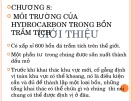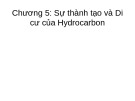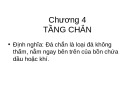
1
1
Chapter 08
Chapter 08
THE
THE HABITA OF
HABITA OF
HYDROCARBONS IN
HYDROCARBONS IN
SEDIMENTARY BASINS
SEDIMENTARY BASINS

2
2
Introduction
There are approximately 600 sedimentary rock
basins in the world.
A quarter of them are producing petroleum
Before exploitating in a new area, attemting to
locate
drillabe prospects, it is necessery to
establish the
type of basin, what
productive horizons it may
contain and where they may be broadly located

•Even though petroleum reserves can be found in
rocks of all ages, most giant fields and most of
the world's reserves occur in sequences, of Late
Mesozoic and Cenozoic age ( Figure ) .
Paleozoic rocks probably had potential to
generate hydrocarbons equal to that of these
younger rocks, but there has been more time in
which to destroy all or part of the petroleum
through uplift and erosion (Halbouty et al,
1970).
3
3

4
4

•Worldwide reserves can be related to their location within a
petroleum basin, regardless of its basin type (Figure )
5
5










![Bài giảng Bẫy dầu khí [mới nhất]](https://cdn.tailieu.vn/images/document/thumbnail/2021/20211215/thienlangso/135x160/361639531179.jpg)



![Quy hoạch tổng thể Cà Mau: Tài liệu [mới nhất/chuẩn nhất]](https://cdn.tailieu.vn/images/document/thumbnail/2025/20250827/tghong1621@gmail.com/135x160/49401756278390.jpg)


![Bài giảng Hàng hải địa văn [chuẩn nhất]](https://cdn.tailieu.vn/images/document/thumbnail/2025/20250729/vijiraiya/135x160/43361753782101.jpg)
![Bài giảng Trắc địa cơ sở [mới nhất]](https://cdn.tailieu.vn/images/document/thumbnail/2025/20250729/vijiraiya/135x160/84_bai-giang-trac-dia-co-so.jpg)





![Atlas tài nguyên nước Việt Nam: Tài liệu [Mô tả/Hướng dẫn/Chi tiết]](https://cdn.tailieu.vn/images/document/thumbnail/2025/20250715/vijiraiya/135x160/348_tai-lieu-atlas-tai-nguyen-nuoc-viet-nam.jpg)
![Hệ thống câu hỏi ôn tập Vùng kinh tế [chuẩn nhất]](https://cdn.tailieu.vn/images/document/thumbnail/2025/20250709/kimphuong1001/135x160/76921752140578.jpg)
